

N24 Awareness Day. Imagine if you came to work one day and your boss told you that a new law had declared that work would start one hour earlier every day.
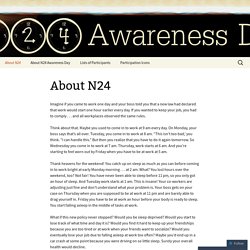
If you wanted to keep your job, you had to comply . . . and all workplaces observed the same rules. Think about that. Maybe you used to come in to work at 9 am every day. On Monday, your boss says that’s all over. Tuesday, you come in to work at 8 am. Thank heavens for the weekend! What if this new policy never stopped? This is what life is like for people who live with N24 (non-24-hour Sleep-Wake Syndrome.) N24 is chronic and debilitating. To learn more about N24, read the words of people who live with it. Like this: Like Loading... Gallant Lab homepage — Gallant Lab at UC Berkeley. Sympathetic nervous system. The sympathetic nervous system (SNS) is part of the autonomic nervous system (ANS), which also includes the parasympathetic nervous system (PNS).

The sympathetic nervous system activates what is often termed the fight or flight response. Like other parts of the nervous system, the sympathetic nervous system operates through a series of interconnected neurons. NGIDD. The nervous system is the control center of our body.
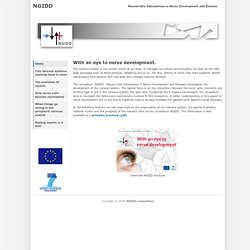
It manages our actions and thoughts, but also all the vital body processes such as blood pressure, breathing and so on. For this, billions of nerve cells work together, strictly coordinating their actions. But how does this intricate network develop? The consortium ‘NGIDD’ (Neuron-Glia Interactions in Nerve Development and Disease) investigates the development of the nervous system. The special focus is on the interaction between the nerve cells (neurons) and another type of cell in the nervous system, the glial cells.
Haas.pdf. Changes in network activity with the progression of Parkinson's disease. In this longitudinal PET study, we found that early stage PD is associated with progressive changes in regional metabolism at key nodes of the two functional brain networks that characterize this disorder.

Increasing regional metabolism was observed within elements of the motor-related PDRP network, which evolved in parallel with deterioration in striatal DAT binding and UPDRS motor ratings. In contrast, the declines in cortical metabolism that were seen with advancing disease were associated with changes in the activity of the cognition-related PDCP network. Significant elevations in PDCP activity occurred late in the follow-up period, and did not correlate with motor ratings or with dopaminergic imaging measures of disease progression.
These findings indicate that the functioning of motor- and cognition-related neural systems is dissociated at the earliest symptomatic phases of the disease. An Update on DAT Scanning for Parkinson’s Disease Diagnosis. You can find out more about NPF's National Medical Director, Dr.

Michael S. Okun, by also visiting the NPF Center of Excellence, University of Florida Center for Movement Disorders & Neurorestoration. Dr. Okun is also the author of the Amazon #1 Parkinson's Best Seller 10 Secrets to a Happier Life. Functional connectivity in the basal ganglia network differentiates PD patients from controls. Longitudinal changes in task-evoked brain responses in Parkinson's disease patients with and without mild cognitive impairment.
Introduction Cognitive impairment frequently accompanies the characteristic motor deficits in Parkinson's disease (PD), ranging from mild cognitive impairment (MCI) to dementia (Kehagia et al., 2010; Svenningsson et al., 2012).
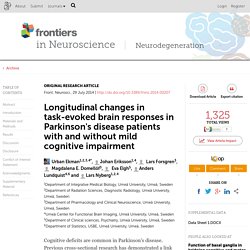
Approximately 20–40% of patients with PD have MCI at an early phase (Aarsland et al., 2010), and the risk of developing PD dementia (PDD) is markedly increased for patients with MCI compared to patients without MCI (Janvin et al., 2006; Broeders et al., 2013; Pedersen et al., 2013). Compulsive hoarding: current controversies and new directions. Neural Mechanisms of Decision Making in Hoarding Disorder. National Institute of Neurological Disorders and Stroke (NINDS) - new template. International Parkinson and Movement Disorder Society. Parkinson’s Disease Research, Education and Clinical Centers Home. Memory Loss & the Brain. Neuropharmacology. Fs38_druginducedparkinsonism.pdf. Dana Foundation - Home.
Trinity College Institute of Neuroscience. Psychosomatica. On the Pharm. KIN450-Neurophysiology - home. Depression and Anxiety. Information and depression symptoms. Depression refers to both negative affect (low mood) and/or absence of positive affect (loss of interest and pleasure in most activities) and is usually accompanied by an assortment of emotional, cognitive, physical and behavioural symptoms.
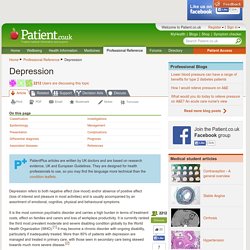
It is the most common psychiatric disorder and carries a high burden in terms of treatment costs, effect on families and carers and loss of workplace productivity. It is currently ranked the third most prevalent moderate and severe disabling condition globally by the World Health Organization (WHO).[1] It may become a chronic disorder with ongoing disability, particularly if inadequately treated. More than 80% of patients with depression are managed and treated in primary care, with those seen in secondary care being skewed towards much more severe disease.[2] Persistent sadness or low mood nearly every day.Loss of interests or pleasure in most activities.
Plus some of the following symptoms: DSM-5 was published in 2013. Risk factors Screening. Lewy Body Dementia Association. Lewy body dementia symptoms and diagnostic criteria Every person with LBD is different and will manifest different degrees of the following symptoms.
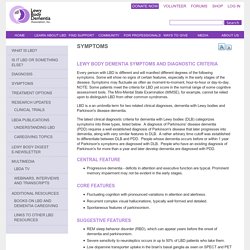
Some will show no signs of certain features, especially in the early stages of the disease. Symptoms may fluctuate as often as moment-to-moment, hour-to-hour or day-to-day. NOTE: Some patients meet the criteria for LBD yet score in the normal range of some cognitive assessment tools. The Mini-Mental State Examination (MMSE), for example, cannot be relied upon to distinguish LBD from other common syndromes. Parkinson's UK - Homepage. Welcome to Parkinson's Australia.
Parkinson's Australia - About PD.